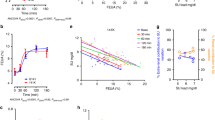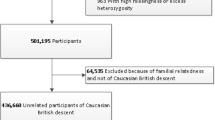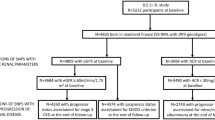Abstract
Background:
Chronic inflammation and obesity may contribute to the genesis or progression of BPH and BPH-associated lower urinary tract symptoms (LUTS). The influence of variants in genes related to these states on BPH has not been studied extensively. Thus, we evaluated the association of 17 single-nucleotide polymorphisms (SNPs) in immune response genes (IL1B, IL6, IL8, IL10, TNF, CRP, TLR4 and RNASEL) and genes involved in obesity, including insulin regulation (LEP, ADIPOQ, PPARG and TCF7L2), with BPH.
Methods:
BPH cases (N=568) and age-frequency matched controls (N=568) were selected from among adult male CLUE II cohort participants who responded in 2000 to a mailed questionnaire. BPH was defined as BPH surgery, use of BPH medications or symptomatic BPH (American Urological Association Symptom Index Score ⩾15). Controls were men who had not had BPH surgery, did not use BPH medications and whose symptom score was ⩽7. Age-adjusted odds ratios (ORs) and 95% confidence intervals (CIs) were estimated using logistic regression.
Results:
None of the candidate SNPs was statistically significantly associated with BPH. However, we could not rule out possible weak associations for CRP rs1205 (1082C>T), ADIPOQ rs1501299 (276C>A), PPARG rs1801282 (-49C>G) and TCF7L2 rs7903146 (47833T>C). After summing risk alleles, men with ⩾4 had an increased BPH risk compared with those with ⩽1 (OR, 1.78; 95% CI, 1.10–2.89; Ptrend=0.006).
Conclusions:
SNPs in genes related to immune response and obesity, especially in combination, may be associated with BPH.
This is a preview of subscription content, access via your institution
Access options
Subscribe to this journal
Receive 4 print issues and online access
$259.00 per year
only $64.75 per issue
Buy this article
- Purchase on Springer Link
- Instant access to full article PDF
Prices may be subject to local taxes which are calculated during checkout
Similar content being viewed by others
References
Espinosa G . Nutrition and benign prostatic hyperplasia. Curr Opin Urol 2013; 23: 38–41.
Bostanci Y, Kazzazi A, Momtahen S, Laze J, Djavan B . Correlation between benign prostatic hyperplasia and inflammation. Curr Opin Urol 2013; 23: 5–10.
Parsons JK, Sarma AV, McVary K, Wei JT . Obesity and benign prostatic hyperplasia: clinical connections, emerging etiological paradigms and future directions. J Urol 2013; 189 (1 Suppl): S102–S106.
Untergasser G, Madersbacher S, Berger P . Benign prostatic hyperplasia: age-related tissue-remodeling. Exp Gerontol 2005; 40: 121–128.
Kristal AR, Arnold KB, Schenk JM, Neuhouser ML, Weiss N, Goodman P et al. Race/ethnicity, obesity, health related behaviors and the risk of symptomatic benign prostatic hyperplasia: results from the prostate cancer prevention trial. J Urol 2007; 177: 1395–1400.
Rohrmann S, Smit E, Giovannucci E, Platz EA . Associations of obesity with lower urinary tract symptoms and noncancer prostate surgery in the Third National Health and Nutrition Examination Survey. Am J Epidemiol 2004; 159: 390–397.
Rohrmann S, Fallin MD, Page WF, Reed T, Partin AW, Walsh PC et al. Concordance rates and modifiable risk factors for lower urinary tract symptoms in twins. Epidemiology 2006; 17: 419–427.
Dranoff G . Cytokines in cancer pathogenesis and cancer therapy. Nat Rev Cancer 2004; 4: 11–22.
Tsan MF . Toll-like receptors, inflammation and cancer. Semin Cancer Biol 2006; 16: 32–37.
Casey G, Neville PJ, Plummer SJ, Xiang Y, Krumroy LM, Klein EA et al. RNASEL Arg462Gln variant is implicated in up to 13% of prostate cancer cases. Nat Genet 2002; 32: 1–2.
Ahima RS, Osei SY . Adipokines in obesity. Front Horm Res 2008; 36: 182–197.
Altshuler D, Hirschhorn JN, Klannemark M, Lindgren CM, Vohl MC, Nemesh J et al. The common PPARgamma Pro12Ala polymorphism is associated with decreased risk of type 2 diabetes. Nat Genet 2000; 26: 76–80.
Grant SF, Thorleifsson G, Reynisdottir I, Benediktsson R, Manolescu A, Sainz J et al. Variant of transcription factor 7-like 2 (TCF7L2) gene confers risk of type 2 diabetes. Nat Genet 2006; 38: 320–323.
Block G, Hartman AM, Naughton D . A reduced dietary questionnaire: development and validation. Epidemiology 1990; 1: 58–64.
Barry MJ, Fowler FJ, O’Leary MP, Bruskewitz RC, Holtgrewe HL, Mebust WK et al. The American Urological Association symptom index for benign prostatic hyperplasia. J Urol 1992; 148: 1549–1557.
Tsilidis KK, Helzlsouer KJ, Smith MW, Grinberg V, Hoffman-Bolton J, Clipp SL et al. Association of common polymorphisms in IL10, and in other genes related to inflammatory response and obesity with colorectal cancer. Cancer Causes Control 2009; 20: 1739–1751.
Wang MH, Helzlsouer KJ, Smith MW, Hoffman-Bolton JA, Hoffman SC, Grinberg V et al. Association of IL10 and other immune response- and obesity-related genes with prostate cancer in CLUE II. Prostate 2009; 69: 874–885.
Kwiterovich P, White S, Forte T, Bachorik P, Smith H, Sniderman A . Hyperapobetalipoproteinemia in a kindred with familial combined hyperlipidemia and familial hypercholesterolemia. Arteriosclerosis 1987; 7: 211–225.
Long J, Williams R, Urbanek M . An E-M algorithm and testing strategy for multiple-locus haplotypes. Am J Human Genet 1995; 56: 799–810.
Schaid DJ, Rowland CM, Tines DE, Jacobson RM, Poland GA . Score tests for association between traits and haplotypes when linkage phase is ambiguous. Am J Hum Genet 2002; 70: 425–434.
Carlson CS, Aldred SF, Lee PK, Tracy RP, Schwartz SM, Rieder M et al. Polymorphisms within the C-reactive protein (CRP) promoter region are associated with plasma CRP levels. Am J Hum Genet 2005; 77: 64–77.
Kupelian V, McVary KT, Barry MJ, Link CL, Rosen RC, Aiyer LP et al. Association of C-reactive protein and lower urinary tract symptoms in men and women: results from Boston Area Community Health survey. Urology 2009; 73: 950–957.
St Sauver JL, Sarma AV, Jacobson DJ, McGree ME, Lieber MM, Girman CJ et al. Associations between C-reactive protein and benign prostatic hyperplasia/lower urinary tract symptom outcomes in a population-based cohort. Am J Epidemiol 2009; 169: 1281–1290.
Schenk JM, Kristal AR, Neuhouser ML, Tangen CM, White E, Lin DW et al. Biomarkers of systemic inflammation and risk of incident, symptomatic benign prostatic hyperplasia: results from the prostate cancer prevention trial. Am J Epidemiol 2010; 171: 571–582.
Schenk JM, Kristal AR, Neuhouser ML, Tangen CM, White E, Lin DW et al. Serum adiponectin, C-peptide and leptin and risk of symptomatic benign prostatic hyperplasia: results from the Prostate Cancer Prevention Trial. Prostate 2009; 69: 1303–1311.
Michalakis K, Williams CJ, Mitsiades N, Blakeman J, Balafouta-Tselenis S, Giannopoulos A et al. Serum adiponectin concentrations and tissue expression of adiponectin receptors are reduced in patients with prostate cancer: a case control study. Cancer Epidemiol Biomarkers Prev 2007; 16: 308–313.
Jiang M, Strand DW, Franco OE, Clark PE, Hayward SW . PPARgamma: a molecular link between systemic metabolic disease and benign prostate hyperplasia. Differentiation 2011; 82: 220–236.
Willson TM, Lambert MH, Kliewer SA . Peroxisome proliferator-activated receptor gamma and metabolic disease. Annu Rev Biochem 2001; 70: 341–367.
Florez JC, Jablonski KA, Bayley N, Pollin TI, de Bakker PI, Shuldiner AR et al. TCF7L2 polymorphisms and progression to diabetes in the Diabetes Prevention Program. N Engl J Med 2006; 355: 241–250.
Sarma AV, Kellogg Parsons J . Diabetes and benign prostatic hyperplasia: emerging clinical connections. Curr Urol Rep 2009; 10: 267–275.
Mullan RJ, Bergstralh EJ, Farmer SA, Jacobson DJ, Hebbring SJ, Cunningham JM et al. Growth factor, cytokine, and vitamin D receptor polymorphisms and risk of benign prostatic hyperplasia in a community-based cohort of men. Urology 2006; 67: 300–305.
Turner DM, Williams DM, Sankaran D, Lazarus M, Sinnott PJ, Hutchinson IV . An investigation of polymorphism in the interleukin-10 gene promoter. Eur J Immunogenet 1997; 24: 1–8.
Acknowledgements
We appreciate the contributions of staff of the Johns Hopkins George W. Comstock Center for Public Health Research and Prevention in the conduct of the CLUE II study. Dr Lopez was supported by a National Research Service Award from the National Cancer Institute (T32 CA009314). This work was supported by the American Institute for Cancer Research, the National Institute of Aging (U01 AG18033), the National Cancer Institute (N01 CO12400) and the National Cancer Institute Prostate Cancer Specialized Program of Research Excellence (Career Development Award from P50 CA58236). Cancer incidence data have been provided by the Maryland Cancer Registry, Center for Cancer Surveillance and Control, Department of Mental Health and Hygiene. We acknowledge the State of Maryland, the Maryland Cigarette Restitution Fund, and the National Program of Cancer Registries (NPCR of the Centers for Disease Control and Prevention (CDC)) for the funds that helped support the availability of the cancer registry data.
Author information
Authors and Affiliations
Corresponding author
Ethics declarations
Competing interests
The authors declare no conflict of interest.
Rights and permissions
About this article
Cite this article
Lopez, D., Peskoe, S., Tsilidis, K. et al. Association of variants in genes related to the immune response and obesity with BPH in CLUE II. Prostate Cancer Prostatic Dis 17, 353–358 (2014). https://doi.org/10.1038/pcan.2014.36
Received:
Revised:
Accepted:
Published:
Issue Date:
DOI: https://doi.org/10.1038/pcan.2014.36
This article is cited by
-
Influence of Age and Obesity on 5α-Reductase 2 Gene Expression
Current Bladder Dysfunction Reports (2016)



